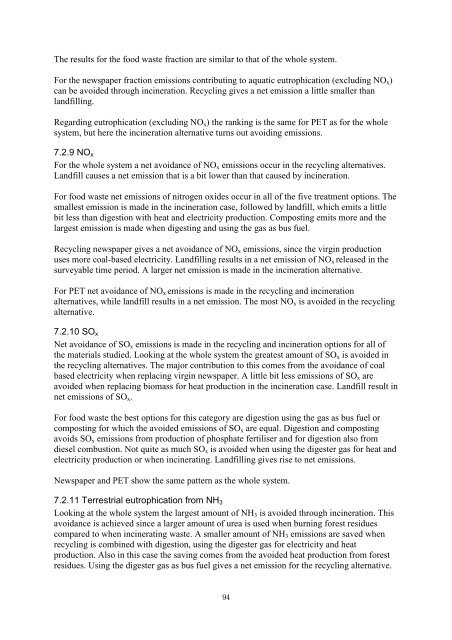Life Cycle Assessments of Energy From Solid Waste (PDF)
Life Cycle Assessments of Energy From Solid Waste (PDF)
Life Cycle Assessments of Energy From Solid Waste (PDF)
Create successful ePaper yourself
Turn your PDF publications into a flip-book with our unique Google optimized e-Paper software.
The results for the food waste fraction are similar to that <strong>of</strong> the whole system.<br />
For the newspaper fraction emissions contributing to aquatic eutrophication (excluding NO x )<br />
can be avoided through incineration. Recycling gives a net emission a little smaller than<br />
landfilling.<br />
Regarding eutrophication (excluding NO x ) the ranking is the same for PET as for the whole<br />
system, but here the incineration alternative turns out avoiding emissions.<br />
7.2.9 NO x<br />
For the whole system a net avoidance <strong>of</strong> NO x emissions occur in the recycling alternatives.<br />
Landfill causes a net emission that is a bit lower than that caused by incineration.<br />
For food waste net emissions <strong>of</strong> nitrogen oxides occur in all <strong>of</strong> the five treatment options. The<br />
smallest emission is made in the incineration case, followed by landfill, which emits a little<br />
bit less than digestion with heat and electricity production. Composting emits more and the<br />
largest emission is made when digesting and using the gas as bus fuel.<br />
Recycling newspaper gives a net avoidance <strong>of</strong> NO x emissions, since the virgin production<br />
uses more coal-based electricity. Landfilling results in a net emission <strong>of</strong> NO x released in the<br />
surveyable time period. A larger net emission is made in the incineration alternative.<br />
For PET net avoidance <strong>of</strong> NO x emissions is made in the recycling and incineration<br />
alternatives, while landfill results in a net emission. The most NO x is avoided in the recycling<br />
alternative.<br />
7.2.10 SO x<br />
Net avoidance <strong>of</strong> SO x emissions is made in the recycling and incineration options for all <strong>of</strong><br />
the materials studied. Looking at the whole system the greatest amount <strong>of</strong> SO x is avoided in<br />
the recycling alternatives. The major contribution to this comes from the avoidance <strong>of</strong> coal<br />
based electricity when replacing virgin newspaper. A little bit less emissions <strong>of</strong> SO x are<br />
avoided when replacing biomass for heat production in the incineration case. Landfill result in<br />
net emissions <strong>of</strong> SO x .<br />
For food waste the best options for this category are digestion using the gas as bus fuel or<br />
composting for which the avoided emissions <strong>of</strong> SO x are equal. Digestion and composting<br />
avoids SO x emissions from production <strong>of</strong> phosphate fertiliser and for digestion also from<br />
diesel combustion. Not quite as much SO x is avoided when using the digester gas for heat and<br />
electricity production or when incinerating. Landfilling gives rise to net emissions.<br />
Newspaper and PET show the same pattern as the whole system.<br />
7.2.11 Terrestrial eutrophication from NH 3<br />
Looking at the whole system the largest amount <strong>of</strong> NH 3 is avoided through incineration. This<br />
avoidance is achieved since a larger amount <strong>of</strong> urea is used when burning forest residues<br />
compared to when incinerating waste. A smaller amount <strong>of</strong> NH 3 emissions are saved when<br />
recycling is combined with digestion, using the digester gas for electricity and heat<br />
production. Also in this case the saving comes from the avoided heat production from forest<br />
residues. Using the digester gas as bus fuel gives a net emission for the recycling alternative.<br />
94
















